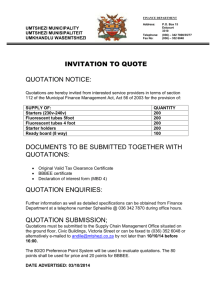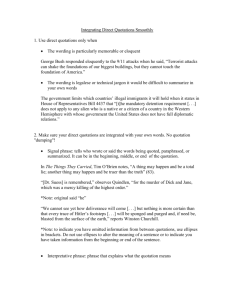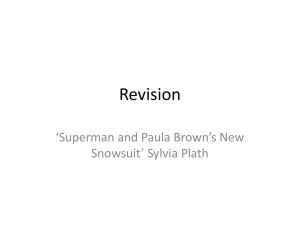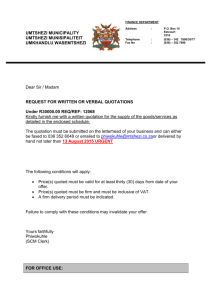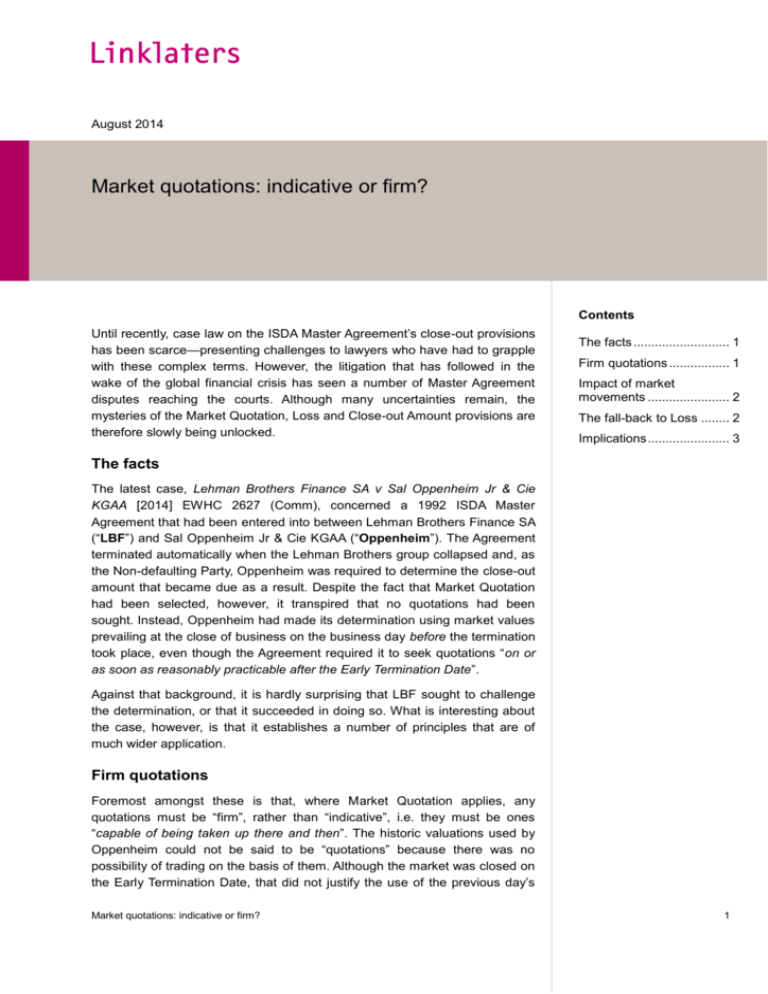
August 2014
Market quotations: indicative or firm?
Contents
Until recently, case law on the ISDA Master Agreement’s close-out provisions
has been scarce—presenting challenges to lawyers who have had to grapple
with these complex terms. However, the litigation that has followed in the
wake of the global financial crisis has seen a number of Master Agreement
disputes reaching the courts. Although many uncertainties remain, the
mysteries of the Market Quotation, Loss and Close-out Amount provisions are
therefore slowly being unlocked.
The facts ........................... 1
Firm quotations ................. 1
Impact of market
movements ....................... 2
The fall-back to Loss ........ 2
Implications ....................... 3
The facts
The latest case, Lehman Brothers Finance SA v Sal Oppenheim Jr & Cie
KGAA [2014] EWHC 2627 (Comm), concerned a 1992 ISDA Master
Agreement that had been entered into between Lehman Brothers Finance SA
(“LBF”) and Sal Oppenheim Jr & Cie KGAA (“Oppenheim”). The Agreement
terminated automatically when the Lehman Brothers group collapsed and, as
the Non-defaulting Party, Oppenheim was required to determine the close-out
amount that became due as a result. Despite the fact that Market Quotation
had been selected, however, it transpired that no quotations had been
sought. Instead, Oppenheim had made its determination using market values
prevailing at the close of business on the business day before the termination
took place, even though the Agreement required it to seek quotations “on or
as soon as reasonably practicable after the Early Termination Date”.
Against that background, it is hardly surprising that LBF sought to challenge
the determination, or that it succeeded in doing so. What is interesting about
the case, however, is that it establishes a number of principles that are of
much wider application.
Firm quotations
Foremost amongst these is that, where Market Quotation applies, any
quotations must be “firm”, rather than “indicative”, i.e. they must be ones
“capable of being taken up there and then”. The historic valuations used by
Oppenheim could not be said to be “quotations” because there was no
possibility of trading on the basis of them. Although the market was closed on
the Early Termination Date, that did not justify the use of the previous day’s
Market quotations: indicative or firm?
1
figures: quotations should instead have been sought on the following day,
when the market reopened. It follows that, where quotations are sought after
the Early Termination Date, the enquiry is not about the price at which a
replacement transaction could have been entered into on the Early
Termination Date. The price to be quoted is the amount that will be payable if
the quotation is accepted (albeit that the term of the transaction must be
backdated so as to start on the Early Termination Date). The quotation will
therefore reflect the market value of the transaction at the time it is provided.
Impact of market movements
Oppenheim sought to justify its approach by pointing out that the market
movements occurring around the Early Termination Date were at least partly
caused by the insolvency of LBF’s holding company, which was an Event of
Default under the Master Agreement. When calculating any close-out amount,
it has to be assumed (amongst other things) that no Event of Default exists.
This, argued Oppenheim, means that any impact on the market of the Event
of Default must also be disregarded. This argument was decisively rejected.
Quite apart from the fact that the previous day’s price is not necessarily the
price that would have prevailed but for the Event of Default (so that it would
be a matter of speculation what that price would have been), such a
conclusion would make no commercial sense. Whether the market goes up or
down after the Early Termination Date, the Non-defaulting Party must pay, or
is entitled to receive, a sum that represents the price of a replacement
transaction on, or as soon as reasonably practicable after, that date. In either
case, it is made whole.
The fall-back to Loss
Oppenheim also pointed out that a Non-defaulting Party is not required to use
the Market Quotation methodology if a Market Quotation cannot be
determined or, in its reasonable belief, would not produce a commercially
reasonable result. In these circumstances, the Loss methodology applies
instead, which gives the Non-defaulting Party a wider discretion to decide
how to determine the close-out amount. By the time the market reopened,
Oppenheim had hedged its positions and so did not need to enter into
replacement transactions. It therefore argued that it was entitled to use Loss
in substitution for Market Quotation.
This argument was also rejected. It was clear that a Market Quotation could
have been determined, albeit by waiting until the day after the Early
Termination Date to obtain the necessary quotations. The question, therefore,
was whether Oppenheim could rationally have believed that this would not
have produced a commercially reasonable result. In fact there was no
evidence that Oppenheim had formed such a belief, or that it had directed its
mind to the question at all. Even if it had done so, the fact that it was
reasonable to hedge its exposure otherwise than by entering into
replacement transactions did not mean that the use of the Market Quotation
methodology was unreasonable. It would have been irrational to have
concluded otherwise and so any determination it might have made to this
Market quotations: indicative or firm?
2
effect could have been challenged. This shows that the fall-back to Loss
cannot be used retrospectively to justify a failure to follow the Market
Quotation procedure properly, on the basis that it would not have produced a
commercially reasonable result anyway: the Non-defaulting Party must have
reached such a conclusion at the time it makes its determination.
The Court’s reasoning also throws some light on the operation of the Loss
methodology. Like Market Quotation, this requires the close-out amount to be
determined as of the Early Termination Date “or, if that is not reasonably
practicable, as of the earliest date thereafter as is reasonably practicable”. It
follows that the use of quotations, or market values, from a time prior to the
Early Termination Date is not permissible, even if the market is closed on the
Early Termination Date. Indeed, the same is true under the 2002 ISDA Master
Agreement. Although that expressly permits the use of indicative quotations,
any quotations that are used must represent the position on the Early
Termination Date, or as soon as is commercially reasonable thereafter.
Implications
Although nothing in this judgment should come as a surprise, it is far from
true that the procedure required by the ISDA Master Agreement is universally
followed. In many instances, dealers who are asked for quotations expressly
state that the quotations are provided for valuation purposes only, or that
trading is subject to internal approval. It is now clear that these do not qualify
as quotations under the Market Quotation provision, which will often mean
that Loss must be used instead. This, in turn, gives rise to further issues,
including the extent to which it is reasonable to use indicative quotations in
that context and whether the Non-defaulting Party ought to mitigate its loss by
using the most favourable quotation available. These are questions that have
yet to be fully examined by the Courts.
Furthermore, parties requesting quotations often state that they are doing so
in order to value a transaction, so that they do not intend to trade on the basis
of them. Where this is done and firm quotations are not provided, the Market
Quotation methodology will not have been properly followed. The Defaulting
Party will therefore be entitled to challenge the Non-defaulting Party’s
determination if it can show that a sufficient number of firm quotations would
have been provided if they had been requested. There will be no fall-back to
Loss in such a case: the Court will simply do its best to work out what the
result would have been if the Market Quotation procedure had been properly
followed. Given the frequency with which errors of this nature are made,
Oppenheim is unlikely to be alone in facing such a remedy.
Simon Firth
Market quotations: indicative or firm?
3
Contacts
For further information
please contact:
Simon Firth
Partner
(+44) 20 7456 3764
simon.firth@linklaters.com
This publication is intended merely to highlight issues and not to be comprehensive, nor to provide legal advice. Should
you have any questions on issues reported here or on other areas of law, please contact one of your regular contacts, or
contact the editors.
© Linklaters LLP. All Rights reserved 2014
Linklaters LLP is a limited liability partnership registered in England and Wales with registered number OC326345. It is a
law firm authorised and regulated by the Solicitors Regulation Authority. The term partner in relation to Linklaters LLP is
used to refer to a member of Linklaters LLP or an employee or consultant of Linklaters LLP or any of its affiliated firms or
entities with equivalent standing and qualifications. A list of the names of the members of Linklaters LLP together with a list
of those non-members who are designated as partners and their professional qualifications is open to inspection at its
registered office, One Silk Street, London EC2Y 8HQ or on www.linklaters.com and such persons are either solicitors,
registered foreign lawyers or European lawyers.
Please refer to www.linklaters.com/regulation for important information on our regulatory position.
We currently hold your contact details, which we use to send you newsletters such as this and for other marketing and
business communications.
We use your contact details for our own internal purposes only. This information is available to our offices worldwide and to
those of our associated firms.
If any of your details are incorrect or have recently changed, or if you no longer wish to receive this newsletter or other
marketing communications, please let us know by emailing us at marketing.database@linklaters.com.
One Silk Street
London EC2Y 8HQ
Telephone (+44) 20 7456 2000
Facsimile (+44) 20 7456 2222
Linklaters.com
Market quotations: indicative or firm?
//
4


